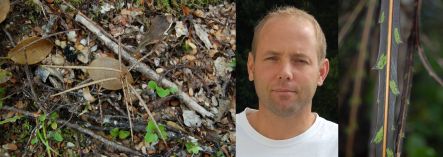Our Changing World for Thursday 3 September 2009
Plant adaptation against predation

(Images: Kevin Burns)
Kevin Burns (above) from Victoria University of Wellington and a team of scientists have tested whether leaf colour changes in the lancewood plant (Pseudopanax crassifolius) may have been part of a defensive strategy against the now extinct moa. They tested this hypothesis in the lab, and the results were recently published in New Phytologist.
The team used spectrographic measurements on different-sized plants grown in a common garden and compared these results with observations on a closely related species that evolved in the absence of moa on the Chatham Islands. While animals often use colours to advertise defences or hide from predators, there is little evidence for colour-based defence in plants.
Their spectrographic analyses showed that birds would have difficulty distinguishing seedling leaves against a background of leaf litter (see image left above). The brightly coloured tissues next to the spines on the sapling leaves, on the other hand, are highly conspicuous to birds (see image right above). The Chatham Island species lacks these colour changes completely. The results suggest that the plants did in fact adapt to limit predation.
Carbon dioxide capture

(Images: IRL and Ruth Beran)
Capturing carbon dioxide from large emitters of greenhouse gas, such as coal-fired power stations, and then burying or "sequestering" this gas under the ground, is one approach to mitigating human-induced climate change.
The main hurdle is that current carbon dioxide capturing technology is often expensive and requires more energy, but scientists at Industrial Research Limited they have found the holy grail of affordable and efficient capture of carbon dioxide by reactivating lime (see some samples of lime before and after reactivation above).
Ruth Beran met with Robert Holt and Susan Edwards (above right) in a shed at IRL where their research using a fluidised bed (above left) is based to see if they would let her in on the secret process they have discovered.
Modelling Animal Movements
Mathematician turned zoologist and computer modeller Mike Paulin, from the University of Otago's Zoology Department, is interested in animal movement, biomechanics and the brain. His research involves studying how animals move, and creating mathematical and computer models of movement. He is particularly interested in dynamic walking - he says 'the concept of "passive dynamic locomotion" is causing biologists to re-think ideas about animal and human agility, and engineers to re-think the design of walking robots, as it seems stable gait can emerge from mechanical design, with no need for muscles or a brain.'
MSc student Stefan Reussenzehn (below right) is studying the mechanical design of the legs of a large nursery web spider Dolomedes aquaticus (below centre), as it seems spiders may capture and recycle energy in elastic fluid reservoirs, making passive dynamic legged locomotion possible even at this small scale.

MSc student Kiri Pullar (above left) is using a technique called model-based Bayesian inference to determine how the same species of spider moves. She uses "markerless motion capture" to compare images generated by a computer model of a spider to images from high-speed video of real spiders.
There are videos and images of all the research on Mike Paulin's website; you can find the dancing robots on Youtube.